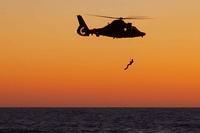Sequestration and the Pentagon's ongoing budget pressures do not appear to be slowing the urgent multi-service response to the Philippines and the humanitarian relief being rushed to the super typhoon-damaged areas, Pentagon officials said.
However, despite the apparent ease with which the Philippine effort appears to be progressing, the ability of the U.S. military to respond to humanitarian disasters such as this moving forward may be substantially reduced by continued sequestration.
As the U.S. rushes military assets, food, water and medical supplies to help disaster-ravaged Filipinos with aircraft carriers, amphibious assault ships, C-130 aircraft and other assets; costs and continued sequestration may not seem to be a pressing or immediate concern.
The seemingly limitless nature of the humanitarian disaster, coupled with U.S. resolve to stand by its ally, is the most immediate pressing concern, defense officials explained. Pentagon leaders couldn't estimate how much the Defense Department has spent thus far, but officials expect cost to grow as the relief effort continues over time.
"Given that the carrier group has not received tasking nor can anyone predict how long these ships will be on station, it is difficult to estimate the total cost to be incurred. Our focus is, and ought to be, on doing what we can to assist those efforts led by the Philippine government," a defense official told Military.com
However, the relief effort takes place within the broader context of sequestration and budget challenges which are quite likely to impact U.S. military readiness and the services ability to respond to crisis such as this, military officials emphasized.
Defense leaders have told Congress that these budget cuts associated with sequestration will severely limit the military's readiness and troops will not be prepared to respond to dynamic situations such as typhoon relief in the Pacific. However, the military and its units responded quickly to the calls for help from the Philippine government.
"The impact of sequestration on these types of mission grows over time and may not be felt immediately," a defense official said.
Pentagon officials told Military.com that there would increasingly be effort to catalogue and examine costs of the relief effort.
"The Pentagon will be capturing costs as this unfolds," said Pentagon spokesman Bill Urban.
The Philippine relief effort appears to be aided by the fact that the U.S. Navy permanently bases several assets in nearby Japan, a defense official said.
"The Philippines is close to Japan, where we have our only forward deployed aircraft carrier. That is a lot easier than steaming a carrier from San Diego. Location and proximity helped the relief effort in this case," a defense official said.
The USS George Washington carrier is based in Japan, as are at least two amphibious assault ships. Overall, the Navy is sending the USS George Washington, along with two cruisers and a destroyer. The cruisers are the USS Antietam and the USS Cowpens, and the destroyer is the USS Mustin.
While most Navy ships have a reverse osmosis capability allowing them to create fresh water from the ocean, the USS George Washington can generate up to 400,000 gallons of drinking water per day, officials said.
The two amphibs -- the USS Germantown and the USS Ashland -- are slated to arrive off the Philippine shores after picking up U.S. Marines in Okinawa, Japan. A Navy supply ship, the USNS Charles Drew, is also helping the effort, officials said.
Nearly 280 U.S. military personnel are in the Philippines along with Marine Corps MV-22 Osprey tiltrotors and KC-130J aircraft. So far, the aircraft have delivered more than 107,000 pounds of relief supplies, according to a statement from U.S. Mari ne Corps Forces, Pacific.
"The most significant thing in the last 24 hours is that military flights in an out of Tacloban have continued 24 hours. There are flights going in and out of there non-stop. The airfield is powered, which enables night time flights," Sgt. Ben Eberle, spokesman with Marine Corps Forces, Pacific, told Military.com.
So, while the Philippine effort appears thus far unencumbered by financial stress and pressure, this may not be the case in the future.
In fact, Chief of Naval Operations Adm. Jonathan Greenert recently told the Senate Armed Services Committee that continued sequestration will have a damaging effect on readiness and crisis response.
"Reductions in our operations and maintenance will result in only one non-deployed carrier strike group and one amphibious ready group trained and ready for contingency response. Our covenant with the combatant commanders is to have at least two carrier strike groups and two amphibious ready groups deployed and to have another three of each in or around the continental U.S. ready to respond to a crisis on short notice," Greenert said. "We have to operate forward where it matters and we got to be ready when it matters. We have to be able to respond to contingencies with acceptable readiness."
One defense official underscored the concern that continued sequestration will negatively impact the ability of the services to respond to global humanitarian disasters.
"Crisis missions are the things that do come out of the operations accounts -- sequestration hits the operations accounts," the official said.




























